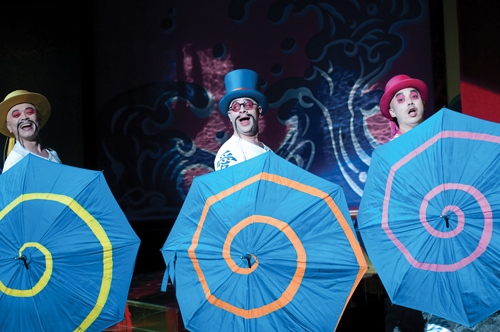By Samantha Test
Northwest Asian Weekly

From left to right: Joseph Hu (Pong), Patrick Carfizzi (Ping), and Julius Ahn (Pang) (Photo by Elise Bakketun)
Seattle’s latest opera, “Turandot,” is a love story.
However, the love story is not just in the plot, but in the context, too. It is the story of fascination, imagined realities, and historical influences that the East and West have had on each other for generations. The production of the story was also a labor of love for the Seattle Opera, which sought to incorporate Chinese culture in a balanced way.

Lori Phillips as Turandot on opening night. (Photo by Elise Bakketun)
“[Turandot] is inspired by China, but is not a Chinese opera,” said Renaud Doucet, Turandot’s director and choreographer. “What was important to us was to put on stage the fascination, and not the reality.”
Set and costume designer Andrew Barbe and Doucet wanted to depict the actual historical influences that led to the creation of the opera.
They worked to create a balance between the perceived but inaccurate realities written into the play and the overall fancy of a fairy tale.
While many details of Turandot are viewed as stereotypical or as a product of misled exoticism, the opera is celebrated for its representation of an era.
“We immersed ourselves into the Chinese culture and read about lots of things, looked at all the architecture we possibly could,” said Barbe.
“Since it’s a fairy tale and was written by a gentleman who never went to China, but was in love with the image of China, we wanted to keep that aspect of the fairy tale.”
Giacomo Puccini wrote Turandot, a story set in 19th century China, without ever setting foot in China. He started the opera in 1924, in an era when Western views of the East were dominated by exoticism. After Puccini’s death, it was finished in 1926 by Franco Alfano.
This story centers on the beautiful but icy Princess Turandot and Prince Calaf, who falls in love with her. Before the prince can obtain permission to marry the princess, he, like all other suitors, must solve three riddles. A wrong answer to one riddle will result in death.
Breaking the pattern of many executed princes, Prince Calaf becomes the first to pass the test.
Barbe also drew on the era when the opera was made to influence costume design.
“We wanted to speak a little bit about the fact that the opera was created in 1926. So the flavor of it, for example of Ping, Pong, and Pang, is very much a burlesque or vaudeville style. … We wanted to give them this flavor of the 1920s, so they’re drinking martinis and one is wearing a bowler hat, one is wearing a straw hat, and one is wearing a top hat. It was also to show the Westernized influence [that it had on] China at the time,” said Barbe.
Ping, Pong, and Pang are three ministers in the opera that work for Turandot in governmental roles. Tired of an endless stream of suitors that inevitably end up failing Turandot’s riddles and being put to death, they try unsuccessfully to convince Prince Calaf not to become a suitor.
“In many ways, they are the same character,” said tenor Julius Ahn, a Korean American who plays Pang.
“It’s three different people, but they move together, sometimes they finish each other’s sentences, or they start another’s thought.”
Joseph Hu, a Taiwanese American tenor, plays Pong in the trio with Ahn.
“I like Pong very much. In the opera, he says how he wants to go back home, to his province, and my parents are from that province,” Hu says of his character and the tie he feels to his Chinese parents while playing him.
Hu also points out details in what he calls a ‘quasi-Chinese story’ that are more accurate to the culture like the practice of riddles and the test or fight to win a bride. In their research, Doucet and Barbe also found more details that showed a deeper reverence for the Chinese culture than most would expect.
“Puccini, by his use of numbers, is really respecting Chinese numerology,” said Doucet. “It was very striking when we started looking at the score, and started looking at Chinese culture and the impact of numerology on this. The goal was to make sure we were respecting those [elements], because it is important. And who knows, if we are successful, maybe it’s because we placed people by eight.”
The culture, it seems, is in the details. But whether the opera finds success in Seattle for respecting these details or through the overall themes, it will certainly be due to a balance of both.
“There are many, many references to the Eastern world, the exoticism of the late 19th century that Europeans were so fascinated by, but ironically, I think [the audience] will walk away not thinking about the exoticism,” said Ahn. “I think they will walk away with the bigger picture about love, about humanity, about sacrificing and giving, about how not everything is what it seems, and of course the music, the incredible music.” (end)
Samantha Test can be reached at info@nwasianweekly.com.



